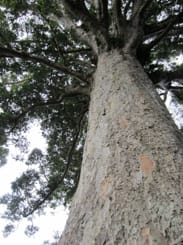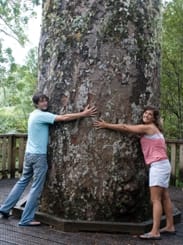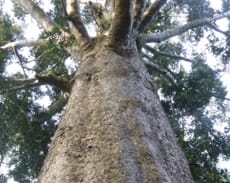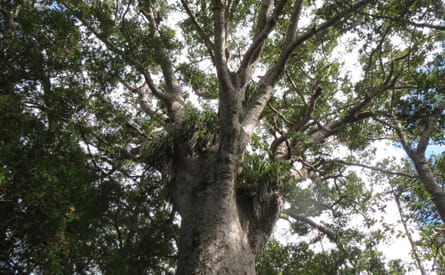

Kauri Tree (Agathis Australis)
Proving date: 1993
Proving completed by: The School of Homeopathy
Common name : Kauri Tree
Download: Full proving Kauri Tree (Agathis Australis)
Download: Proving rubrics
About the Kauri Tree
The lord of the ancient forest.
Kauri patients typically hold positions of great responsibility and feel the pressure that this role of leadership, or being a respected person, has bestowed upon them. They may feel guilty for perceived failures and rebuke themselves because they think they are falling short of their high goals. They may yearn for the past that feels forever lost; a time of dancing and frivolity. This feels like a wound that will not heal, longing for something that has irrevocably slipped away. They may fall prey to bulimia, or otherwise self-harm. They may feel detached, separated, adrift, floating and like to reconnect and ground in nature and the simplicity of childhood. Typically, the body may somatise for perceived failures with crippling back, neck and shoulder pains.
There are sensations of shooting, waves of pins and needles, prickling, and twitching. As the pressure builds up in the
Kauri patient, they experience?head pains that are seething, throbbing, and pulsating. Water symptoms present with trickling sensations running down the legs, thirst, everlasting urination, and running noses.
Kauri
Kauri first appeared in the Jurassic Period 190–135 million years ago. Botanically it is a primitive form, as are its relatives, the Norfolk Pine and the Monkey-puzzle tree. Kauri is slow growing and takes on different forms as it grows and matures. Life begins as a spindly, twiggy seedling. There is a high mortality rate at this time, due to desiccation, fungal infection and its need for more light than other trees as kauri requires larger gaps in the forest canopy to regenerate. In areas of the forest that have been damaged or destroyed, kauri seedlings are able to grow easily as a result of increased sunlight and their strong resistance to wind and frosts. Kauri is competitive and will fight for survival by depriving other species of nutrients. Young trees have a strikingly different appearance to their elders and are pyramidal in shape with sharp, pointed, conical crowns. Kauri grow about 30 cm per year when young but after reaching a height of about 5 m, growth slows down. They persist in pyramidal form for 60–100 years until adolescence when the tree begins to shed its lower branches and expands its slender trunk and crown. As it approaches maturity after hundreds of years, and reaches the forest canopy, the kauri breaks out a huge head, sheds the last of its lateral branches, swells and stretches its columnar trunk. The older tree is free of branches for up to 18 m above the ground and they can reach up to 30 m in height, with a trunk up to 3 m in diameter.
Kauri timber is yellow-brown, light, durable, straight-grained, free of knots and other defects and contains a high proportion of heart wood. It does not taint or stain, is resistant to corrosive liquids and stands up to combined heat and moisture without splitting. The bark of young kauri trees is reddish. Mature bark is ash-grey to brown and is relatively thin and smooth, continuously shedding flakes which keeps the trunk free of parasites. The flaking bark creates spectacular patterns on the trunk: an art form of mottled tracery. The leaves are thick and leathery with parallel veins, sessile and arise on the branches either alternately or opposing one another. Leaves of the young trees are bronze and lanceolate whilst adult leaves are bright green and blunt. Young leaves are 5–10 cm long and 5–12 cm wide whilst adult leaves are 2–3.5 cm long. Kauri has a unique relationship with the soil, feeding the organic litter near the surface of the soil through fine root hairs, where the soil is composed of organic matter from falling leaves and branches, in addition to dead trees that cover the ground and are constantly undergoing decomposition. Kauri has higher acidic levels than other trees – as it decays, the acidic compounds are liberated and the molecules pass through the soil in rainwater, releasing nutrients in the clay. Male and female cones of various ages, are borne on the same tree and after about 40 years they produce viable seed. Finger-like male cones fall once their pollen is released through wind dispersal in Spring, and round female cones ripen and release seeds which are carried by the wind or birds. Seeds remain active for a short time and usually germinate when they settle in an open site where light can penetrate readily.
The trees exude copious quantities of gum, either spontaneously or from injured parts. This seals the wound and diterpene acids in the gum act to prevent infection. Old wounds may ‘bleed’ for hundreds – even thousands – of years, forming stalactites aloft and corresponding stalagmites upon the tree’s mighty roots and the forest floor below. Gum accumulates on branches, partly solidifying in stalagmite-like concretions on trunks and at the base of the trees. In old hollow trees, large amounts collect in the base of the trunk. It was usual to find hunks of solidified gum washed up on Northland beaches, much in the manner of amber.
Mythology
Maori legend: chronicles the tale of 2 giants – whale (tohora) and kauri – who exchanged ‘skins’ in mutual admiration. Tohora was presented to Tangaroa (god of the sea) by Tane Mahuta (god of the forest), and the tree's scale-like bark serves as a reminder of the relationship between tohora and kauri.
In the beginning: in Maori lore, was nothingness from which the primal parents of Maori arose – Earth mother (Papatuanuku) and Sky father (Ranginui). They merged in sexual embrace and had 70 sons. Their embrace was so close that no light could enter and so there was no room for their young, who questioned what to do, and decided their parents must be killed. However, Tane Mahuta – the largest and strongest, and god of the forest – convinced his siblings that they only needed to be separated. He, being the mightiest, thrust his roots against Earth and his branches in opposition to Sky, and he slowly and strenuously pushed them apart. The light flooded in, between Earth and Sky, and the World was created.
Te Whakaruruhau: or 'great protector of the forest' is the name Maori have given the tree, personifying it as the mighty defender of the many living creatures and plant life which shelter beneath its shady canopy. The largest kauris have individual names given by Maori to show their respect.
History
Swamp kauri: are those trees which 'have been buried and preserved in peat swamps for between 800 and 60,000 years.' Most swamp kauri is found in lowland bogs and peat swamps of Northland, up to 800m above sea level.
Timber: was used for water transport, canoes, ships, spars, building of dams, settlements and furniture, and was transported mainly by water. Unlike Maori, Europeans had blatant disregard for the spirituality of kauri, which they unceremoniously felled by saw and axe. 30% of the logs were wasted in the process and over half the remainder were burned. It is now illegal for any living kauri tree to be felled. Milling and export of swamp kauri is also regulated under the Forests Act (1949), and responsibility for the extraction of swamp kauri lies with local and regional councils under the Resource Management Act (1991).
Gum: was used in the manufacture of paints, varnishes, polish, and linoleum. It was burnt by Maori to create soot, which was used for tattooing. By the late 1800s, hunting for 'liquid gold' had become commonplace, with gumdiggers working their way across 800,000 acres of Northland, searching for gum nuggets, and 'bleeding' the trees, thereby creating a swathe of devastation over the forests.
Buried treasure: On display at the Kauri Museum, Matakohe, Northland, are many lumps of gum – 'copal' – in which ancient insects have been preserved, trapped in the translucent golden sap, which solidified, and then found itself buried beneath the forest floor in depths up to 100 m, and even at the bottom of lakes.
Light: 2 of the largest kauris – Kopi, known to be hollow and Toronui, the biggest of them all, who proved to be hollow – have crashed to the ground in recent years.
Medical uses: Sap was scraped down to produce a powder and then mixed with olive oil to treat burns. Maori used the gum as a fire lighter, and boiled the resin until soft and chewable to treat digestive disorders. Vermeulen writes that gum, according to the Dispensatory of the USA (1918), ‘... has been used with alleged great success in the treatment of wounds and ulcers, of eczema and other skin affections ... When applied to a well cleansed and dried wound it leaves a slight deposit of resin as a varnish, which is not affected by friction or contact with water.’
The proving
The impulse to prove Kauri was based upon a variety of impressions, which included the mythology, staggering age, size and splendour of the mature trees. The deciding factor however, was the signature of the unhealing wound of broken branches from which resinous gum perpetually oozes. The harvester, Elisha Norrie wrote, ‘As we had agreed, I bored a small hole through the bark of Yakas, but not before sitting in the stillness of the bush and meditating upon the task, asking that the spirit of trees and forest offer this up willingly, so that the homoeopathic remedy could be made. I was overcome with longing and loneliness as I began to collect the sap, so that I had to take care not to accidentally let a tear fall into the vial.’ The sap issuing from a small wound inflicted by a knife flows as fast as tears, the internal sap pressure being so high and so it is unsurprising that water featured strongly in the proving; also sexuality relating in part, to the swelling phallic trunk. Imagine the young tree psyche discovering and learning, adapting and settling into its niche. This presented with imagery of champagne-like innocence and effervescent joy. There was also marshmallow dullness and out of body delusions similar to those of Thuja. As the expanding growth and shape of the tree suggests, many head and back symptoms featured in the proving, with a focus on the third eye, and imagery and sensations of a jouster. The giant kauri grew the largest, lived the longest, and was the lord of the forest. It was logged to within an inch of extinction and powerless to prevent its demise. Small wonder then, that there is a pervading sense of loss and self-hate in the remedy, for a past that can never come again. This yearning may become an isolating, unfeeling and numbing experience. It is a wound that cannot heal: 'I listened to the radio. I was very much alert and anxious today. I was thinking of my best friends who betrayed me in the past. It flashes back and forth, but I was able to control it'.
Images out of time
It is simple to know that the grandeur of oceans as they crash upon reefs and beaches are creations of a God in eternal bliss who also casts upon the shifting sands of time skeletons innumerable, bones of whales, Kauri gum and sea-shell dust. / The agony before death, chaos of body, like tremors under Earth, when the solidity of rock is changed into water’s wave, challenges precepts of certainty. / Let them go, all impermanent ideas, for the place from which we begin our journey is a no man’s land of imponderability where we may wish to dream into being all forests and rivers, fishes and fauns, dragonflies’ wings and the myriad things, / For each is a variant upon the theme of the blueprint of the Mistress of forms. / We may wish to slumber beside Her, in the aura of Her warmth, in range of the drumming of Her heart beat, and walk Her path upon life’s sands, our smaller steps falling in place within the marks of Her grander feet. / Apprenticed to Gods we may be, inventing the details of our lives, prescribing the remedies for our diseases, finding the panorama, such as nature unfolds, that enlivens our spirit and mirrors an inner view of soul which pleases. / Intention and pattern correspond as in the veining of a leaf, as in the spirals of shells; to know the one is to be drawn into the perfumed garden of the heart where lovers spin their spells. / Thus apprenticed to Gods yet being of human kind, we may well steer into the wind of wisdom, and ultimately find that this world of pleasures and pains, does reflect the heavenly realm.
Misha Norland, Images out of time, New Zealand
Download: Full proving Kauri Tree (Agathis Australis)
Download: Proving rubrics

Unhealing wound - Champagne - Innocence - Sexuality - Giant - Water - Jouster - Marshmallow - Unfeeling - Self-hate
Proving Themes
Kingdom: Plantae
Division: Pinophyta
Class: Pinopsida
Order: Pinales
Family: Araucariaceae
Genus: Agathis
Species: A. australis
Kingdom Taxonomy
The stump of the tree was seen for his beauty and was sought after as an ornamental feature, in addition to being used for making furniture as it was both decorative and strong

.jpg)

